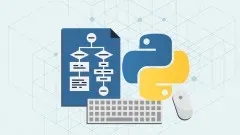
Algorithms and Data Structures in Python (INTERVIEW Q&A)

This course is perfect for anyone looking to learn the fundamentals of data structures, algorithms and graphs in Python. It covers topics such as setting up the environment, arrays, linked lists, stacks and queues, binary search trees, AVL trees and red-black trees, priority queues and heaps, hashing and dictionaries, graph traversal, shortest path problems, spanning trees, substring search algorithms, Hamiltonian cycles, sorting algorithms and algorithms analysis. Each chapter includes theoretical background and step-by-step code implementation in Python. This course is ideal for those looking to use Python in fields such as investment banking, artificial intelligence or electronic trading algorithms on the stock market. Join now and start learning!▼
Course Feature
![]() Cost:
Cost:
Paid
![]() Provider:
Provider:
Udemy
![]() Certificate:
Certificate:
Paid Certification
![]() Language:
Language:
English
![]() Start Date:
Start Date:
2023-07-04
Course Overview
❗The content presented here is sourced directly from Udemy platform. For comprehensive course details, including enrollment information, simply click on the 'Go to class' link on our website.
Updated in [July 18th, 2023]
This course, Algorithms and Data Structures in Python (INTERVIEW Q&A), is designed to provide an overview of data structures, algorithms and graphs. Students will learn to implement the problems in Python programming language. The course will cover topics such as setting up the environment, differences between data structures and abstract data types, arrays, linked lists, stacks and queues, binary search trees, balanced binary trees (AVL Trees and Red-Black Trees), priority queues and heaps, hashing and dictionaries, graph traversal, shortest path problems (Dijkstra's and Bellman-Ford Algorithms), spanning trees (Kruskal's and Prim's Approaches), substring search algorithms, Hamiltonian cycles (Travelling Salesman Problem), sorting algorithms, and algorithms analysis. Students will gain an understanding of the theoretical background of each algorithm or data structure, and will write the code step by step in Python. This course is beneficial for those interested in fields such as investment banking, artificial intelligence, or electronic trading algorithms on the stock market.
Pros & Cons
-

Good teaching with clear explanation: Users appreciate the instructor's teaching style and find the explanations to be clear, which helps them understand the concepts effectively.
-

Visuals and simple explanations: The instructor builds up concepts with visuals and simple explanations, making it easier for users to grasp the growing complexity of the topics presented.
-

Lack of accessibility for newcomers: Some users, especially those with limited programming experience and no formal educational training, find the videos to be technical and precise in a way that obstructs comprehension. They feel that the instructor could have used analogies and provided more relatable explanations.
-

Course structure and content organization: A few users feel that the course puts too much emphasis on theory before defining different algorithms and data structures. They suggest that the course should have started with a clearer introduction to the concepts and gradually introduced more complex topics. Additionally, some users mention that the course does not cover all the necessary notation and technical language, despite being advertised as suitable for Python beginners.
Course Provider





